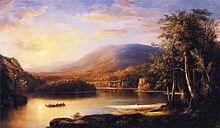Robert S. Duncanson
The primary art historical debate centered on Duncanson concerns the role that contemporary racial issues played in his work.Charles received special privileges, including his emancipation and the opportunity to learn a skilled trade, because he was likely the illegitimate son of his owner.In response, Charles, his son John Dean, and his wife Lucy Nickles, like many free African Americans, moved north.[13] It was also referred to as the "emporium of the West" by its free black population who had much greater access to opportunities of advancement there than in other parts of antebellum America.[10] During the 19th century, Cincinnati and the American west became well known for its landscape artists, including William Louis Sonntag, Godfrey Frankenstein, T. Worthington Whittredge, and Duncanson himself.[2] In the 1840s, Duncanson worked primarily as an itinerant portrait painter, like many African-American artists at the time, traveling among Cincinnati, Detroit, and Monroe, Michigan.This exhibition served as his public debut to the art world, but none of Duncanson’s family members were permitted to attend the show because of their race."[18] In 1851, Duncanson's created one more well-known landscape paintings from this time period, Blue Hole, Flood Waters, Miami River.In 1853, Duncanson embarked on the traditional "grand tour" of Europe, completed by many contemporary artists, which exposed him to the art world and provided inspiration for many of his future landscape works.[2] Many of Duncanson's paintings, such as Land of the Lotus Eaters, were influenced by works of British Romantic poets to include mythical themes.The opportunities provided by these "grand tours" of Europe gave Duncanson the ability to study the works of the Old Masters while exploring the historic landscapes of the European countryside.[22] Abolitionist patrons provided him with ample commissions, acquired his paintings, financed his travel to various locations nationally and abroad, and introduced him to other prominent people in the art community.Abolitionists were motivated to support artists like Duncanson because it emphasized the abilities of African Americans to participate in and contribute to mainstream culture.The North, particularly cities like Cincinnati with substantial black populations and strong abolitionist presences, was a more advantageous place for African-Americans to pursue fine arts professions.For example, Joseph Ketner II argues that in Duncanson's painting Garden of Eden (1852) "paradise with its palm trees might also be the promised land of slave songs."[2] Other art historians, like Margaret Rose Vendryes, assert that Uncle Tom and Little Eva (1853) demonstrates Duncanson's desire to satisfy abolitionist patrons, and not necessarily his own views.[20] Duncanson's success in the Cincinnati art community brought him many substantial commissions, such as that of Nicholas Longworth, one of the city's wealthiest citizens.Duncanson's work on the murals in the Belmont Mansion greatly increased his popularity in the art community of Cincinnati, particularly among the white abolitionist contingent.[2] Art historian Joseph D. Ketner considers Ellen's Isle, Loch Katrine to be the "pinnacle of [Duncanson's] aesthetic and technical accomplishments.Robert Seldon Duncanson was one of few African American landscape painters of the nineteenth century, and he achieved levels of success unknown to his contemporaries.[23] By the 1860s, Duncanson was proclaimed to be the "greatest landscape painter in the West" by the American Press and London newspapers held him in equal regard to other British artists at the time.Beginning in the 1990s, art historians like Ketner made an effort to research Duncanson's life and work to develop an accurate portrayal of the artist.Since 1986, the Taft Museum of Art in Cincinnati, Ohio has maintained an artist-in-residence program for contemporary African-American artists in honor of Duncanson.

Fayette, New YorkDetroitSelf-teachingLandscape paintingLandscape with RainbowHudson River SchoollandscapistThomas ColeOhio River ValleyantebellumabolitionistAfrican-Americanart historiansMargaret Rose Vendryestradesmanfreed slavesemancipationUpper SouthartisanMonroe, MichiganMount Pleasant, OhioWilliam Louis SonntagT. Worthington Whittredgeteach himselfprintsengravingssketchingportraitsDaguerregenre paintingMethodistJoe BidenJoshua JohnstonDetroit Institute of ArtsHarriet Beecher StoweUncle Tom’s CabinLake PontchartrainCivil WarNicholas LongworthmuralsTaft Museum of ArtJames Presley Ballcoloring photographic printspanoramic paintingAfrican slave tradeplantationsOtto Reinhold JacobiSir Walter ScottW.E.B. Du BoisFrederick Douglasspastoraldementialead poisoningschizophreniaspiritualismWoodland CemeteryHammonds HouseNational Museum of American ArtDayton Art InstituteTaft MuseumCincinnati Art MuseumHigh Museum of ArtCalifornia African American MuseumNational Museum of African American History and CulturePrinceton University Art MuseumNational Afro-American Museum and Cultural CenterCleveland Museum of ArtThe Columbia Museum of ArtArt Gallery of OntarioMusée national des beaux-arts du QuébecBirmingham Museum of ArtNorth Carolina Central UniversityNewark MuseumAmon Carter Museum of American ArtMuseum of Fine Arts, BostonSmithsonian American Art MuseumArt Association of MontrealMuseum of Modern ArtDenver Art MuseumIndianapolis Museum of ArtHoward UniversityLa Jolla Museum of Contemporary ArtBowdoin CollegeLos Angeles County Museum of ArtMildred Lane Kemper Art MuseumStudio Museum in HarlemList of Hudson River School artistsList of African-American visual artistsPatton, SharonHistorical Society of MichiganAge of EnlightenmentRomanticismVictorianismRealismArtistsCharles BakerWilliam Bliss BakerJohn Dodgson BarrowSusie M. BarstowJulie Hart BeersAlbert Fitch BellowsAlbert BierstadtJames Renwick BrevoortAlfred Thompson BricherWilliam Mason BrownJohann Hermann CarmienckeJohn William CasilearFrederic Edwin ChurchSamuel ColmanJasper Francis CropseyWilliam Moore DavisLockwood de ForestThomas DoughtyAsher Brown DurandHermann FuechselSanford Robinson GiffordRégis François GignouxEliza Pratt GreatorexDaniel Charles GroseJames McDougal HartWilliam HartWilliam Stanley HaseltineMartin Johnson HeadeHermann Ottomar HerzogThomas HillRansome Gillett Holdridge